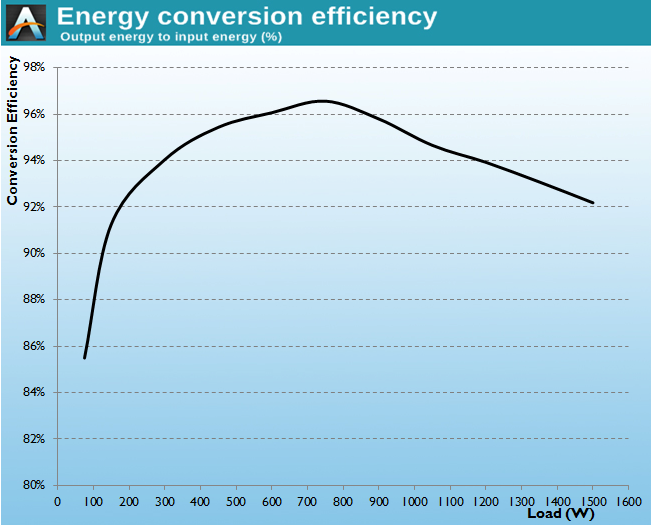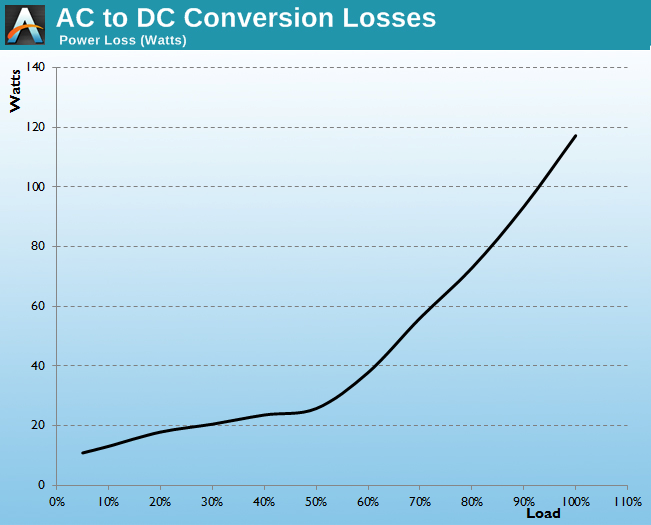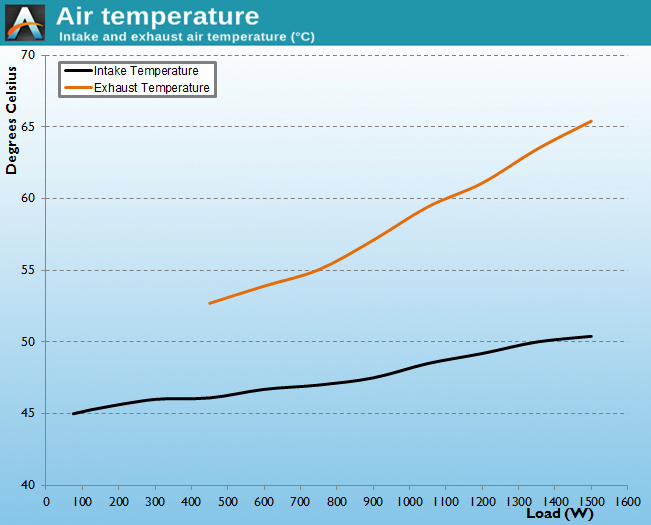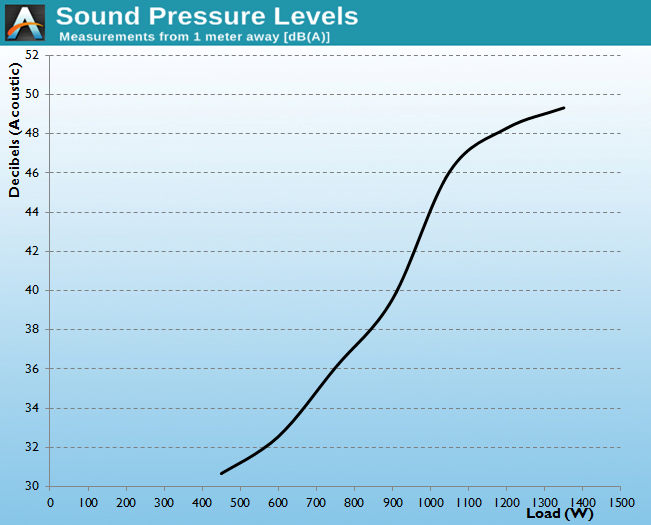Corsair AX1500i Power Supply Review
by E. Fylladitakis on September 11, 2014 5:00 AM EST- Posted in
- Cases/Cooling/PSUs
- Corsair
- PSUs
- 1500W
Hot Test Results
From the tables below, we can see that the output power quality of the Corsair AX1500i is simply setting new performance records. Our instrumentation recorded a maximum ripple of just 16mV on the 12V line under maximum load, while drawing 107.2 Amperes from it! Cross loading the voltage lines had virtually zero effect on the stability of the unit, courtesy of the dual LLC PSU design we mentioned in the Internal Design section. Finally, the voltage regulation is remarkable, with the worst and best results being 0.5% and a mere 0.15% on the 5V and 12V lines, respectively!
| Main Output | ||||||||
| Load (Watts) | 300.98 W | 751.78 W | 1126.37 W | 1501.55 W | ||||
| Load (Percent) | 20.07% | 50.12% | 75.09% | 100.1% | ||||
| Line | Amperes | Volts | Amperes | Volts | Amperes | Volts | Amperes | Volts |
| 3.3 V | 5.15 | 3.34 | 12.86 | 3.34 | 19.3 | 3.33 | 25.73 | 3.33 |
| 5 V | 5.15 | 5.02 | 12.86 | 5.02 | 19.3 | 5 | 25.73 | 4.99 |
| 12 V | 21.44 | 12.03 | 53.6 | 12.02 | 80.4 | 12.01 | 107.2 | 12.01 |
| Line |
Regulation (20% to 100% load) |
Voltage Ripple (mV) | |||||
| 20% Load | 50% Load | 75% Load | 100% Load |
CL1 12V |
CL2 3.3V + 5V |
||
| 3.3V | 0.4% | 6 | 10 | 12 | 12 | 4 | 8 |
| 5V | 0.5% | 4 | 6 | 10 | 12 | 6 | 10 |
| 12V | 0.15% | 6 | 8 | 12 | 16 | 14 | 6 |
High ambient temperature have a miniscule impact on the energy conversion efficiency of the Corsair AX1500i, reducing the average nominal load (20-100%) efficiency down to 94.6% and the maximum efficiency of the PSU to 96.5%. The overall efficiency drop is a mere 0.3% percent over a temperature rise of 25°C, which is simply amazing, displaying both the effectiveness of the design and the quality of the active components. As such, the conversion losses remained nearly unaffected despite the much higher ambient temperature.
Overall, the behavior of the cooling system inside our hot box was similar to our "cool" testing results, with the sole exception being that the fan turns on at a much lower load than before. It also gets noticeably louder, but considering the massive power output, the AX1500i did not get hot at all, suggesting that the thermal control circuit is programmed to maintain low operating temperatures under any circumstance. We would be hard-pressed to find such low temperature readings even in reviews of units with half the capacity of the AX1500i.















55 Comments
View All Comments
CrazyElf - Thursday, September 11, 2014 - link
It will mostly be of use for people who are using quadruple GPU configurations or highly overclocked triple GPU configurations.But yes, as the article notes, it's a niche product and arguably an overpriced product for what it offers. We'll see what similar 1500-1600W PSUs offer by other manufacturers in the coming months.
Vatharian - Thursday, September 11, 2014 - link
Good, you mentioned, almost. I've build recently dual cpu (using Supermicro X9DRG-QF), 5 GPU (Titan black) workstation, water cooled (for sake of efficiency and longevity, not wow factor), and it refused to boot on Corsair AX1200i, switched to dual Seasonic X1250, and it peaks around 2.1kW from wall (on 230V).piroroadkill - Thursday, September 11, 2014 - link
Holy shit. Now that's baller.mapesdhs - Thursday, September 11, 2014 - link
And I thought my quad-580 3930K was nuts. :DCool dude!!
Ian.
Chrispy_ - Monday, September 15, 2014 - link
Assuming you're running an SSI EEB board, you should really be using server-grade EPS supplies rather than this consumer junk. Drawing 2.1kW from the wall is all the evidence you should need for this! ;)Barilla - Thursday, September 11, 2014 - link
80+ and 80+ titanium are two different things. And there are actually some people that need this kind of power, although not many.Sabresiberian - Thursday, September 11, 2014 - link
You know what is really useless? Comments about how a product is useless.They do more to show how limited the imaginations of the authors (of such comments) are than anything else.
petteyg359 - Sunday, February 15, 2015 - link
Just because you don't give a crap about efficiency doesn't mean others won't. Going from 84% to 92% efficiency on a 500W load is over 1.2 kWh saved every day. At $0.15 per KWh, the PSU will more than pay for itself within the warranty period.Pissedoffyouth - Thursday, September 11, 2014 - link
As a 220v user (New Zealand), due to higher efficiency should we also see lower temperatures?DanNeely - Thursday, September 11, 2014 - link
Slightly. 220v is generally 1-2% more efficient than 110; meaning at full load you'd have 15-30W lower losses being converted into heat.